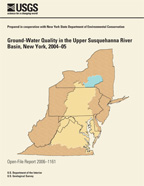Open-File Report 2006–1161
By Kari K. Hetcher-Aguila and David A.V. Eckhardt
U.S. Geological Survey Open-File Report 2006–1161
 |
Front Cover - PDF format (453 KB)
|
Water samples were collected from 20 production wells and 13 private residential wells throughout the upper Susquehanna River Basin (upstream from the Pennsylvania border) during the fall of 2004 and the spring of 2005 and analyzed to describe the chemical quality of ground water in the upper basin. Wells were selected to represent areas of greatest ground-water use and highest vulnerability to contamination, and to provide a representative sampling from the entire (4,516 square-mile) upper basin. Samples were analyzed for physical properties, nutrients, inorganic constituents, metals, radionuclides, pesticides, volatile organic compounds, and bacteria.
The cations that were detected in the highest concentrations were calcium, magnesium, and sodium; the anions that were detected in the greatest concentrations were bicarbonate, chloride, and sulfate. The predominant nutrient was nitrate, the concentrations of which were greater in samples from sand and gravel aquifers than in samples from bedrock. The metals barium, boron, cobalt, copper, and nickel were detected in every sample; the metals with the highest concentrations were barium, boron, iron, manganese, strontium, and lithium. The pesticide compounds detected most frequently were atrazine, deethylatrazine, alachlor ESA, and two degradation products of metolachlor (metolachlor ESA and metolachlor OA); the compounds detected in highest concentration were metolachlor ESA and OA. Volatile organic compounds were detected in 11 samples, and concentrations of 3 of these compounds exceeded 1 microgram per liter (μg/L). Methyl tert-butyl ether (MTBE), a gasollline additive, was not detected in any sample.
Several analytes were found in concentrations that exceeded Federal and New York State water-quality standards, which are typically identical. Chloride concentrations exceeded the U.S. Environmental Protection Agency (USEPA) Secondary Maximum Contaminant Level (SMCL) of 250 milligrams per liter (mg/L) in two samples, and sulfate concentrations exceeded the SMCL of 250 mg/L in one sample. Sodium concentrations exceeded the USEPA Drinking Water Advisory of 60 mg/L in six samples. Nitrate concentrations exceeded the USEPA Maximum Contaminant Level (MCL) of 10 mg/L in one sample and approached this limit (at 9.84 mg/L) in another sample. Barium concentrations exceeded the MCL of 2,000 μg/L in one sample. Iron concentrations exceeded the SMCL of 300 μg/L in five samples, and manganese concentrations exceeded the SMCL of 50 μg/L in 14 samples. Arsenic was detected in seven samples, and the MCL for arsenic (10 μg/L) was exceeded in two samples. Radon-222 exceeded the proposed MCL of 300 picocuries per liter in 24 samples. Any detection of total coliform or fecal coliform bacteria is considered a violation of New York State health regulations; in this study, total coliform was detected in six samples and fecal coliform was detected in one sample, but Escherichia coli (E. coli) was not detected in any sample.
Abstract
Introduction
Study Area
Purpose and Scope
Methods
Site Selection
Sampling and Analytical Methods
Ground-Water Quality
Physical Properties
Nutrients
Inorganic Ions
Metals and Radionuclides
Pesticides
Volatile Organic Compounds
Bacteria
Summary
References Cited
1–2. Maps showing—
| 1. | Location of upper Susquehanna River Basin in New York and of the 33 wells sampled in 2004–05. | |
| 2. | Surficial geology of the upper Susquehanna River Basin in New York and locations of the wells sampled in 2004–05. |
Hetcher-Aguila, K.K. and Eckhardt, D.A.V., 2006, Ground-water quality in the upper Susquehanna River Basin, New York, 2004–05: U.S. Geological Survey Open-File Report 2006–1161, 21 p., online only.
If you have Adobe Acrobat® or Adobe Acrobat Reader® installed on your computer, you may view and print the PDF version of this report. Acrobat Reader, is a free download from Adobe Systems, Inc. Users with disabilities can view information concerning accessibility at access.Adobe.com .
For further information, contact:
Director
U.S. Geological Survey
New York Water Science Center
425 Jordan Road
Troy, NY 12180
(518)285-5600
or visit our Web site at: http://ny.water.usgs.gov